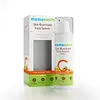What's inside
What's inside
 Key Ingredients
Key Ingredients

 Benefits
Benefits

 Ingredients Side-by-side
Ingredients Side-by-side

Centella Asiatica Leaf Water
Skin Conditioning3-O-Ethyl Ascorbic Acid
Skin ConditioningEthoxydiglycol
HumectantDimethyl Isosorbide
SolventGluconolactone
Skin ConditioningGlycerin
HumectantSodium Gluconate
Skin ConditioningAcetyl Glucosamine
Skin ConditioningSodium Hyaluronate
HumectantPullulan
Hydroxyethylcellulose
Emulsion StabilisingXanthan Gum
EmulsifyingSclerotium Gum
Emulsion StabilisingPhenoxyethanol
PreservativeEthylhexylglycerin
Skin ConditioningLecithin
EmollientLactic Acid
BufferingCitric Acid
BufferingCentella Asiatica Leaf Water, 3-O-Ethyl Ascorbic Acid, Ethoxydiglycol, Dimethyl Isosorbide, Gluconolactone, Glycerin, Sodium Gluconate, Acetyl Glucosamine, Sodium Hyaluronate, Pullulan, Hydroxyethylcellulose, Xanthan Gum, Sclerotium Gum, Phenoxyethanol, Ethylhexylglycerin, Lecithin, Lactic Acid, Citric Acid
Water
Skin ConditioningEthoxydiglycol
HumectantMagnesium Ascorbyl Phosphate
AntioxidantSodium Palmitoyl Proline
Skin ConditioningNymphaea Alba Flower Extract
Skin ConditioningTriheptanoin
Skin ConditioningButylene Glycol
HumectantSodium Hydroxide
BufferingSophora Flavescens Root Extract
AntioxidantGlycyrrhiza Inflata Root Extract
Skin ConditioningScutellaria Baicalensis Root Extract
AstringentAcrylates Crosspolymer
AbsorbentDiethylhexyl Carbonate
EmollientGlycerin
HumectantSqualane
EmollientCaprylhydroxamic Acid
Behenyl Alcohol
EmollientPhysalis Angulata Extract
Skin ProtectingCaprylic/Capric Triglyceride
MaskingTetrahydrocurcumin
AntioxidantCetyl Ricinoleate
EmollientCaesalpinia Spinosa Gum
Skin ConditioningSodium Hyaluronate
HumectantDimethylmethoxy Chromanol
AntioxidantSodium Metabisulfite
AntioxidantWater, Ethoxydiglycol, Magnesium Ascorbyl Phosphate, Sodium Palmitoyl Proline, Nymphaea Alba Flower Extract, Triheptanoin, Butylene Glycol, Sodium Hydroxide, Sophora Flavescens Root Extract, Glycyrrhiza Inflata Root Extract, Scutellaria Baicalensis Root Extract, Acrylates Crosspolymer, Diethylhexyl Carbonate, Glycerin, Squalane, Caprylhydroxamic Acid, Behenyl Alcohol, Physalis Angulata Extract, Caprylic/Capric Triglyceride, Tetrahydrocurcumin, Cetyl Ricinoleate, Caesalpinia Spinosa Gum, Sodium Hyaluronate, Dimethylmethoxy Chromanol, Sodium Metabisulfite
 Reviews
Reviews

Alternatives
Ingredients Explained
These ingredients are found in both products.
Ingredients higher up in an ingredient list are typically present in a larger amount.
Ethoxydiglycol is a synthetic solvent.
Solvents are used to keep ingredients together in a product. They can help dissolve ingredients to stable bases or help evenly distribute ingredients throughout the product.
Ethoxydiglycol also helps deliver other key ingredients into the skin.
Learn more about EthoxydiglycolGlycerin is already naturally found in your skin. It helps moisturize and protect your skin.
A study from 2016 found glycerin to be more effective as a humectant than AHAs and hyaluronic acid.
As a humectant, it helps the skin stay hydrated by pulling moisture to your skin. The low molecular weight of glycerin allows it to pull moisture into the deeper layers of your skin.
Hydrated skin improves your skin barrier; Your skin barrier helps protect against irritants and bacteria.
Glycerin has also been found to have antimicrobial and antiviral properties. Due to these properties, glycerin is often used in wound and burn treatments.
In cosmetics, glycerin is usually derived from plants such as soybean or palm. However, it can also be sourced from animals, such as tallow or animal fat.
This ingredient is organic, colorless, odorless, and non-toxic.
Glycerin is the name for this ingredient in American English. British English uses Glycerol/Glycerine.
Learn more about GlycerinSodium Hyaluronate is hyaluronic acid's salt form. It is commonly derived from the sodium salt of hyaluronic acid.
Like hyaluronic acid, it is great at holding water and acts as a humectant. This makes it a great skin hydrating ingredient.
Sodium Hyaluronate is naturally occurring in our bodies and is mostly found in eye fluid and joints.
These are some other common types of Hyaluronic Acid:
Learn more about Sodium Hyaluronate